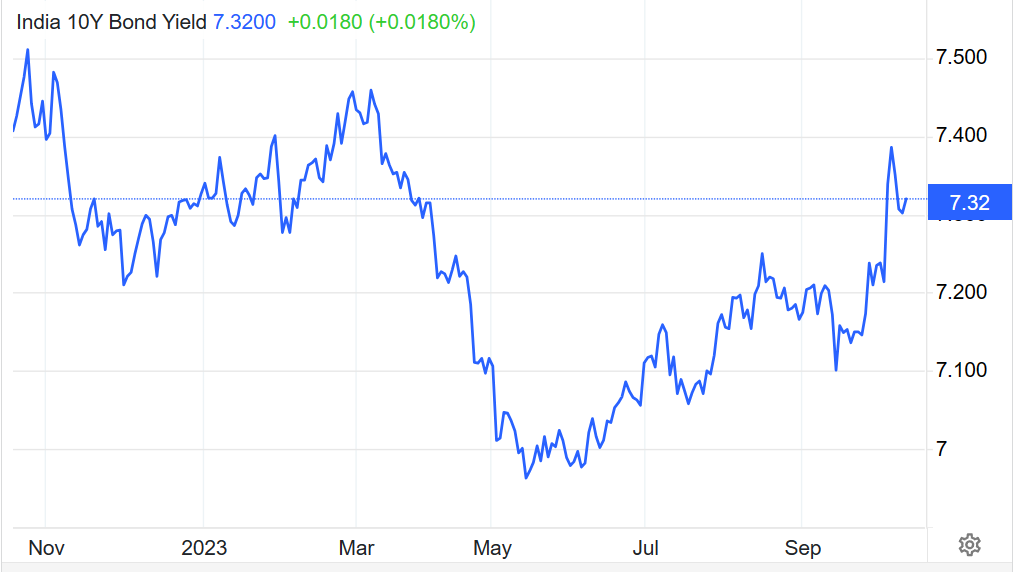
India’s inclusion in a prominent Global Bond Market Index calls for celebration as it will enable the nation’s $1 trillion bond market to seamlessly integrate with global markets, opening avenues for India’s economic growth and financial stability. JP Morgan’s announcement that Indian government securities will now be featured in its prestigious global emerging market bond indices (GBI-EM Global index suite) has garnered considerable attention.
Historically, foreign investor participation in Indian markets has been lacklustre, if not nonexistent. However, the inclusion of G-Secs in GBI-EM Global index suite has the potential to inject a substantial influx of $25-30 billion (equivalent to approximately Rs 2.5 lakh crore) into India’s financial markets over the coming 18 months. The anticipation surrounding this move has stirred significant market excitement, notably increasing trading activity, especially in long-dated bonds.
It is expected to offer enhanced foreign investment at relatively attractive rates, given that India’s benchmark 10-year G-Sec yields stood at an encouraging 7.10% on September 24th, 2023. This momentous development signifies a promising new chapter for India, opening the door to increased global investment and deeper integration of its bond market with the broader international financial landscape.
READ I CBDC future: e-Rupee takes the lead in India’s cashless journey
India breaks into global bond market indices
India’s inclusion in JP Morgan’s Emerging Market-Global Bond Indexing allows India to tap into a larger pool of global investors amid growing pressures on its foreign exchange reserves, a burgeoning current account deficit, and the resultant weakening of the rupee. This can lead to increased foreign investment in India’s G-Sec bonds, facilitating funding for infrastructure projects and stimulating resilient and inclusive economic growth. Moreover, it can result in lower borrowing costs for the government and associated public undertakings because inclusion implies greater liquidity and reduced risk, making Indian bonds more attractive to investors.
Being part of a global index enhances India’s visibility in the global financial markets, as a large portion of qualified investors follows this index. This increased visibility can attract attention from institutional investors and drive greater demand for Indian bonds. Consequently, it can lead to the inclusion of India’s government bonds in their portfolios, diversifying sources of funding and reducing overall portfolio risk.
India 10-year government bond yield

It is estimated that India’s inclusion in the global bond index can attract as much as 10% of the $333 billion global market of investment starting in June 2024, although the actual inflow will be gradual and in phases, with only 1% being added monthly, to be completed by March 2025. Moreover, bond investments are subject to a host of other factors, such as the contemporary regulatory framework, global bond market dynamics, economic and political stability, and India’s business environment.
India’s policymakers have been given another lever to promote greater foreign investment, which can help stabilise India’s rupee, especially during times of heightened volatility caused by a variety of factors. It may also encourage the development of India’s financial markets, including improvements in trading infrastructure and regulatory standards.
Potential challenges for India
The inflow of such a large chunk of foreign investment in a short time window can lead to market volatility due to sudden inflows and outflows of capital, impacting exchange rates and bond yields. When foreign investors hold Indian bonds, they are exposed to exchange rate risk, and movements in the Indian rupee can affect their returns. Moreover, changes in government policies or regulations can impact the attractiveness of Indian bonds to foreign investors, potentially leading to capital flight.
This exposure also highlights macroeconomic vulnerabilities, as India’s economic and fiscal situation can affect the performance of its bonds due to factors such as high rates of inflation, fiscal deficits, or geopolitical tensions. Consequently, global investors may be concerned about the creditworthiness of Indian issuers, as the government’s fiscal health and the credit quality of Indian corporations issuing bonds can influence investor sentiment.
While celebrating our achievement, we should not underestimate the potential challenges associated with currency risk, interest rate risk, regulatory and legal complexities, political and economic risk, including market volatility, issues of legal jurisdiction, transparency, and reporting, exchange rate hedging, and the associated documentation and disclosure.
Regulatory Framework
Considering India’s inclusion in a global bond index, the Reserve Bank of India (RBI) assumes a central role in managing market dynamics, ensuring the competitiveness of the Indian Rupee, and addressing the challenges posed by sudden capital flows, both inflows and outflows, that may trigger market volatility.
First and foremost, the prudent management of foreign exchange reserves by the RBI is paramount. In cases of excessive capital inflows, the RBI can absorb surplus liquidity by acquiring foreign currency assets. This strategic move mitigates upward pressure on the Indian Rupee, safeguarding its competitiveness. Conversely, during episodes of capital outflows, the RBI can deploy its reserves to stabilise the exchange rate, preventing sharp currency depreciation. This dual approach serves to strike a balance between promoting economic stability and maintaining a competitive exchange rate.
Additionally, the RBI possesses a set of powerful tools to navigate capital flow dynamics. It can implement capital flow management measures, such as adjusting foreign portfolio investment limits and enacting temporary capital controls. These measures act as circuit breakers, effectively moderating the pace and magnitude of capital flows and preventing extreme market movements. Furthermore, the RBI has the capacity to influence investor sentiment through interest rate policy adjustments.
Market surveillance and effective communication form the core of the RBI’s strategy, as detecting irregular market movements early allows for timely intervention. Moreover, it clearly communicates the RBI’s policy intentions to guide market expectations, thus reducing uncertainty and reinforcing investor confidence.
Lastly, the RBI can fine-tune liquidity conditions in the banking system through open market operations (OMOs) and diverse policy instruments, thereby maintaining financial stability and preventing disruptions stemming from liquidity shortages. India’s inclusion in a Global Bond Market Index signifies a transformative opportunity for the nation’s bond market, offering both benefits and challenges. The precise impact will depend on India’s economic and political landscape, as well as evolving global market conditions.
(Dr Ram Singh is professor at IIFT New Delhi. Dhriti Mukherjee Pipil is a research scholar at IIFT. Views expressed are personal.)

